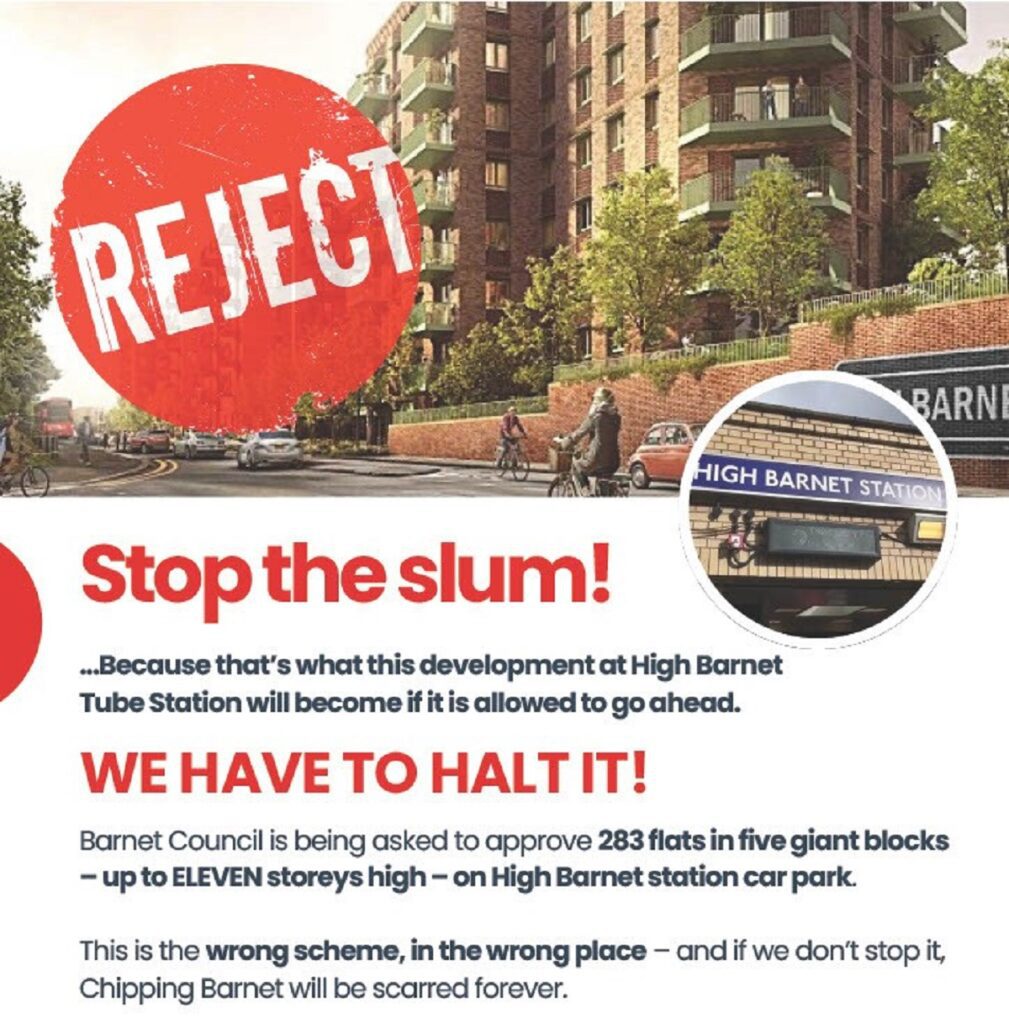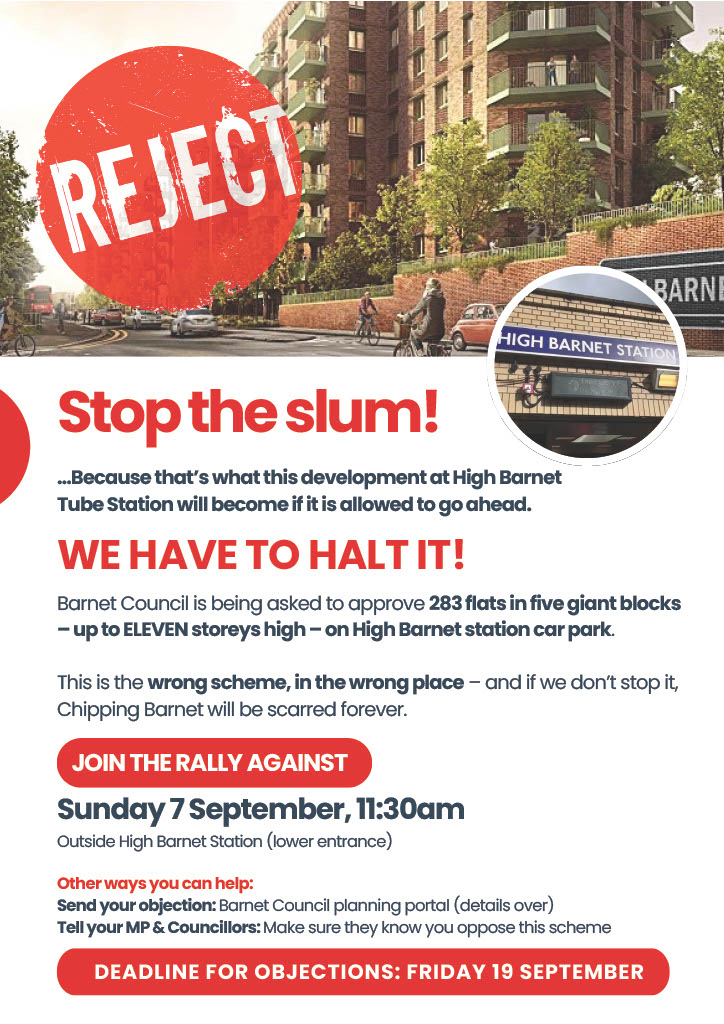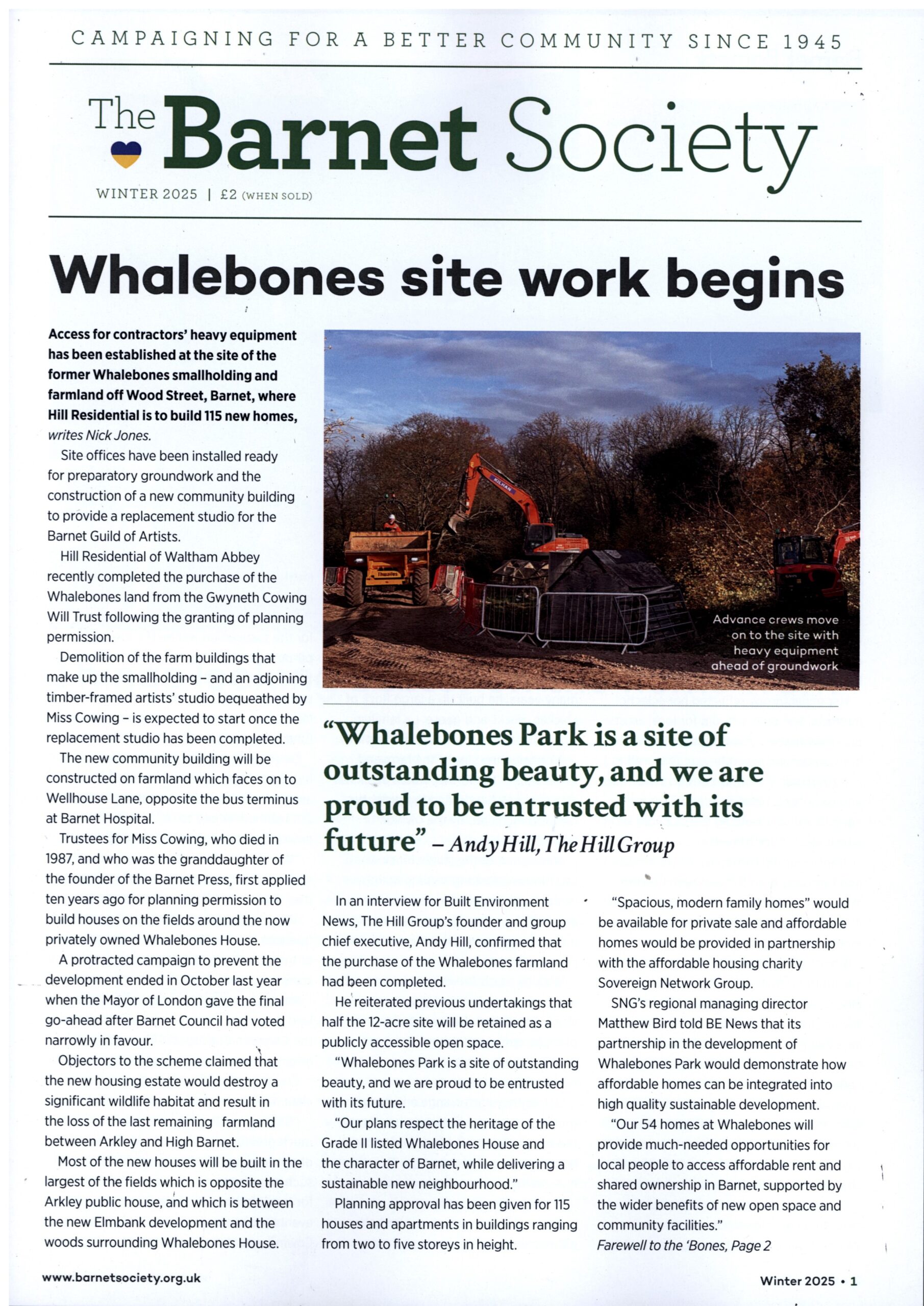Co-ordinated fight back by community groups organising a united front against plans for high rise flats at High Barnet station

Community groups are presenting a united front in objecting to Transport for London’s planning application to build five high-rise blocks of flats on a car park and strip of land alongside the London Underground station for High Barnet.
To highlight the strength of opposition to the “wrong scheme in the wrong place” a rally is to be held on the morning of Sunday 7 September at the lower entrance to the tube station starting at 11.30 am.
Barnet Council has extended until Friday 19 September the deadline for residents to respond to the scheme.
After widespread complaints about the decision to organise public consultation during the summer holidays when so many people were likely to be away, the council acknowledged extra time should be given to ensure residents understood the full impact of the application being made by TfL’s property subsidiary, Places for London.
Leading the way in opposing the scheme are the Barnet Society and the Barnet Residents Association which have both been preparing a detailed list of objections to the application to provide 283 flats in five high storey blocks, one of which would be 11 storeys high.
They say the five blocks of flats are “unattractive and overbearing” and completely out of scale and character for the locality with the eleven-storey block rising above the skyline.
Gordon Massey, who prepared a point-by-point summary of the association’s objections, says the proposed development is a “poorly designed blot on the landscape” with the expectation that the flats would be overwhelmingly purchased by buy-to-let landlords.
Living conditions on the new estate would be poor as 75 of the flats would be single aspect facing west, raising issues of noise, heat and ventilation with the likelihood that with all windows having to remain closed, they would rely on mechanical ventilation.
“We are not opposed to the redevelopment of this site for housing, but the people of High Barnet and future residents of this development deserve something much better than this.”
Mr Massey’s conclusions are in line with those of Robin Bishop, who leads for the Barnet Society on planning and the environment, and who thinks the scheme would have a brutal impact on the existing townscape and greenery of High Barnet, Underhill and Barnet Vale.
“Our main objections to the scheme are to the alien scale and character of the designs; its unsustainability as a neighbourhood; its unsafe environment; and the lack of community benefits.”
Other community groups warn of grave consequences if the development goes ahead with the danger that sandwiching high-rise blocks of tiny flats onto a strip of land between the tube line and Barnet Hill would, in their opinion, be destined to create the slum housing of tomorrow.
Hands Off High Barnet, a campaign group which co-ordinated objections to a 2019 scheme to build seven blocks on the site – a plan which was later reduced and withdrawn – fears the same mistakes are being made once again.
Of the 283 flats being proposed, 68 would be of only one bedroom when High Barnet desperately needed more family homes.
The loss of a well-lit station car park would pose a particular danger for women returning to High Barnet late at night.
“After all the objections we made to the last application, TfL are still not making it any easier for disabled passengers who need to be dropped off or collected at the station,” said Kim Ambridge, one of the founders of Hands-Off High Barnet.
John Dix of the Save New Barnet Campaign – which fought long and hard trying to prevent too many new flats being squeezed into the Victoria Quarter site – said he thought the station scheme was “really shocking”.
The children’s play space in the new development was the “absolute bare minimum” for under 11s.
“One of the children’s play spaces is a steep slope – it drops by 3.3 metres from top to bottom – with steps down the middle underneath one of the blocks.
“They call it the ‘undercroft’ play area, but the wind assessment says it is a problem area and is not for lingering.
“How any human being could classify this dark, draughty underpass as a play area is beyond me.
“The children’s play area for the 12-18-year-olds is, wait for it…500 metres away on Barnet playing fields.”
Mr Dix said he hoped Barnet Councillors read the details of the application, refuse to give approval, and tell the developers to go back to the drawing board.
To raise awareness of TfL’s application and publicise the rally on Sunday 7 September volunteers hope to distribute a leaflet – see below – to around 4,000 households in High Barnet.


Tags: #Barnet Council #High Barnet #Planning
5 thoughts on “Co-ordinated fight back by community groups organising a united front against plans for high rise flats at High Barnet station”
Comments are closed.


Anyone caught in the traffic logjam on the 8th or 9th of September should be aware that this has been caused by temporary traffic lights at the junction of Meadway and Barnet Hill. This single point of roadworks has caused gridlock extending well over a km beyond where the works are taking place, into residential roads, schools areas and back to Barnet Hospital. The Tube Station proposal does not provide any clear plans for how traffic will be impacted/managed during the 3+ years of development. But this timely bit of roadworks should scare all businesses and residents in the area, showing, with a real time example, how any disruption on Barnet Hill can cause widespread chaos in the area. I spoke to several business people who had missed meetings, appointments due to the traffic and I spoke to several bus drivers who said not to bother trying public transport during these works. If the community gets this throughout the development (if approved), the impact to business and the quality of life of residents in the area will be catastrophic. We need more housing for sure, but the highly probable cost to the area of this development seems much too high a price to pay.
Copied from Facebook – note the final paragraph:
BARNET HILL
After Samuel Pepys paid one of his regular visits to Barnet Physic Well in 1660, he mentioned that the road thereto was “only one path and torne, plowed, and digged up, owing to the waggoners carrying excessive weights of over one ton, with more than five horses and oxen to a team”.
In 1754 a decision was made to construct a fair turnpike across Finchley Common but people so little understood the advantage of rendering the transit of goods easy that they obstructed the work. However, the responsibility of making good the highway was given to The Highgate and Whetstone Road Trust and by 1810 it was considered that the eight miles from London to Whetstone was one of the best roads in the kingdom.
In 1823 the then Trustees were informed that the improvement of the whole of The Great North Road from London to Holyhead had been put into the hands of Thomas Telford who declared that the mile and a bit between Pricklers Hill and Barnet town was in need of drastic improvement.
This came as a financial shock to the Trustees as they thought the main repairs would only apply to that part of the road passing through North Wales and not locally. They entrusted themselves to their own surveyor, James McAdam, to oversee the works.
The early 19th century road ran comparatively smoothly along the Whetstone ridge until its descent at Pricklers Hill by the county boundary. It sloped unevenly down, rising again at Underhill House [near where Western Parade is today]. Again it dropped to where Mays Lane curved away beyond the Old Red Lion and then it began its long ascent to the town of Barnet, following a line roughly parallel to Vale Drive before meeting the steepness of the escarpment. It joined the High Street at Victoria Lane, known then as Hog Lane, just below The Red Lion Hotel.
Teams of horses would be waiting at Underhill to be attached to coaches and carriers carts. Hauling was big business in those days for Barnet Hill was a challenge especially in poor weather. Many times passengers had to alight and walk the hill if no extra pairs were available.
Work on Pricklers Hill began and an embankment was raised to smooth out the slope towards Underhill. This ridge is very evident from within Greenhill Park and from the houses on the eastern side. The stream which flowed from the Greenhill House lakes into Dollis Brook was diverted through a drain beneath the road.
Meanwhile Telford had plans for Barnet town. He suggested excavating a gorge through the hilltop in order to lower its brow, the spoil from which would be have been used to level out the severity of the escarpment. This would have the effect of leaving houses overlooking and possibly overhanging an ugly chasm. McAdam came up with an alternative suggestion being what we see today.
His plan was to remove a large quantity of earth from the adjoining fields belonging to the Corporation of the Sons of the Clergy, and for taking a portion of their land to raise an embankment a heavy compensation had to be paid by the Trust. In order to meet this expense it became necessary to borrow money by mortgaging the future tolls of the road.
Work began in 1823 and the final cost, including interest, was expected to reach £17,000. It was clear that in order to meet this expense, and cover the upkeep of the road, the tolls were inadequate. They lobbied to obtain an additional Act which would empower them to increase the tolls, and here there was further pressure as the notorious Bill for the London and Birmingham Railway was also being applied for.
However, the Trustees obtained their Act of Parliament and raised the tolls such that a coach would have to pay more than three shillings [15p] to pass the tollgate. The tolls were let by auction at a sum of £7530 per annum (which equated to more than fifty thousand carriages) and the Trustees began to repay their debts. By the 3rd February 1842 the last payment was made.
It has been said that old ploughshares, iron bedsteads and cannons captured in the Napoleonic War were sunk into the soil to hold it all together. Nevertheless, The Birmingham Railway Bill was passed and the rest is history. Coach travel became obsolete as goods and passengers found they could traverse the countryside quicker by rail and the Whetstone tollgate was discarded in 1863.
Richard Selby
In the adopted Barnet Local Plan, there is a need to build more than 35,000 new homes up to 2036. This site is allocated for residential-led redevelopment, with an indicative capacity of 292 dwellings. The leaflet (the author should read up on the definition of a slum) says this is the “wrong scheme, in the wrong place”.
With the adopted policy context and site allocation in mind, can the Barnet Society outline what the right scheme for this site is? And if it objects to redevelopment of the site, once again bearing in mind the adopted policy position, can you outline where the numbers proposed should go?
I agree the use of the word slum is inappropriate.
Eyesore if the tallest building were to be built would be the best term.
Given the local plan specifies indicative, rather than minimum or target numbers surely it is reasonable that, perhaps, given the reality of the parameters for development that less should be built to a higher standard (less minimum floor space, single aspect flats).
If we want to take the plan at face value then it also states that this is not a site suitable for 8 stories or higher – and yet, despite, ‘community consultation’ (where, people were clearly uncomfortable with the height) PFL increased the height of the development when it went to planning. It’s perplexing that PFL’s opener is so antagonistic.
Is it not possible there should be compromise on both sides? Perhaps, the local community would be more accepting of higher buildings, if in return PFL/Barratts provided decked/underground parking to lessen the local impact on parking. Or, if this proposal included a significant modernisation of the station to provide better disabled access. Or if, to be frank, it wasn’t so damn ugly.
I’m no fan of car parks, and think this site is a perfect opportunity. What I don’t have an answer to is, how (much like with the Victoria Quarter in New Barnet) we can get to a point where big planning applications like these stand a chance of garnering (proper) local support rather than the current adversarial approach. I note that even our local MP who is openly pro-building hasn’t exactly been able to come out extolling the virtues of this project to the local community.